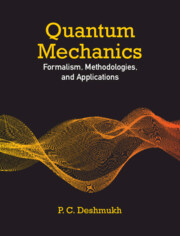Book contents
- Frontmatter
- Dedication
- Contents
- List of Figures
- Foreword
- Preface
- 1 Description of a Physical System
- 2 Path Integral Formulation of Quantum Mechanics
- 3 Probability Tangles and Eigenstates of One-dimensional Potentials
- 4 Angular Momentum
- 5 The Non-relativistic Hydrogen Atom
- 6 Approximation Methods
- 7 The Relativistic Hydrogen Atom
- 8 Quantum Mechanics of Spectral Transitions
- 9 The Many-Electron Atom
- 10 Quantum Collisions
- 11 Introduction to Quantum Information and Quantum Computing
- Appendix A Symmetry of the Hamiltonian
- Appendix B Schrödinger, Heisenberg, and Dirac “Pictures” of Quantum Dynamics
- Appendix C Spherical Harmonics
- Appendix D Occupation Number Formalism Second Quantization
- Appendix E Electron Structure Studies with Qubits
- Index
Appendix A - Symmetry of the Hamiltonian
Published online by Cambridge University Press: 14 September 2023
- Frontmatter
- Dedication
- Contents
- List of Figures
- Foreword
- Preface
- 1 Description of a Physical System
- 2 Path Integral Formulation of Quantum Mechanics
- 3 Probability Tangles and Eigenstates of One-dimensional Potentials
- 4 Angular Momentum
- 5 The Non-relativistic Hydrogen Atom
- 6 Approximation Methods
- 7 The Relativistic Hydrogen Atom
- 8 Quantum Mechanics of Spectral Transitions
- 9 The Many-Electron Atom
- 10 Quantum Collisions
- 11 Introduction to Quantum Information and Quantum Computing
- Appendix A Symmetry of the Hamiltonian
- Appendix B Schrödinger, Heisenberg, and Dirac “Pictures” of Quantum Dynamics
- Appendix C Spherical Harmonics
- Appendix D Occupation Number Formalism Second Quantization
- Appendix E Electron Structure Studies with Qubits
- Index
Summary
A symmetry transformation can be represented on the Hilbert space of physical states by an operator that is either linear and unitary, or anti-linear and anti-unitary.
—Eugene P. WignerA.1 Continuous, Dynamical, and Discrete Symmetries
The role of symmetry in natural laws has been underscored by many, notably by Eugene P. Wigner [1]. Symmetry plays a huge role in our understanding of the laws of nature. Plato (427–327 BCE) recognized that the only regular solids, whose faces are polygons having identical faces meeting at identical solid angles, are the (i) tetrahedron, (ii) cube, (iii) octahedron, (iv) dodecahedron, and (v) icosahedron. Their symmetry properties are celebrated in Euler's theorem
where V is the number of vertices, E the number of edges, and F the number of faces. In 1905, Einstein recognized the symmetry in Maxwell's laws of electrodynamics and formulated the special theory of relativity. This symmetry resulted from the mind-boggling invariance of the speed of light in all inertial frames of reference. It required for its account a non-Euclidean four-dimensional (flat) space–time continuum [Chapter 13 of Reference 2]. Maxwell's theory of electrodynamics engendered an unimaginable constancy of the speed of light in all inertial frames of reference, regardless of their mutual motion. Einstein harbored length-contraction and time-dilation to account for the invariance of the speed of light, which is a fundamental symmetry principle. About ten years later, Einstein interpreted gravity in terms of an equivalence principle, inspired yet again by symmetry. A few years later, in 1918, Emmy Noether established that each conservation law is in essence an equivalent expression of an underlying symmetry. Rudimentary introduction to some of these ideas is now found even in undergraduate texts, such as Reference [2]. In this chapter, we discuss the role of symmetry in atomic structure and dynamics.
The hallmark of quantum theory is the recognition of employing operators to represent dynamical variables of classical mechanics. The simplest symmetry operation is translation through an infinitesimal displacement in homogeneous space.
- Type
- Chapter
- Information
- Quantum MechanicsFormalism, Methodologies, and Applications, pp. 564 - 581Publisher: Cambridge University PressPrint publication year: 2024

